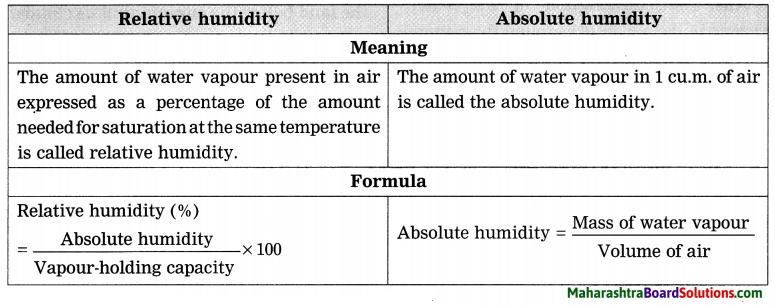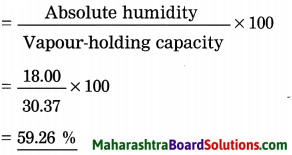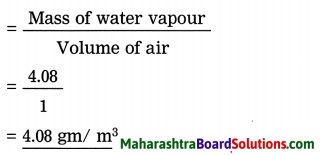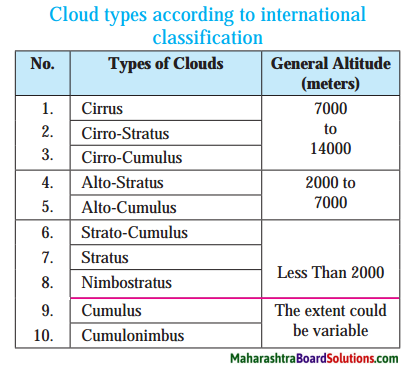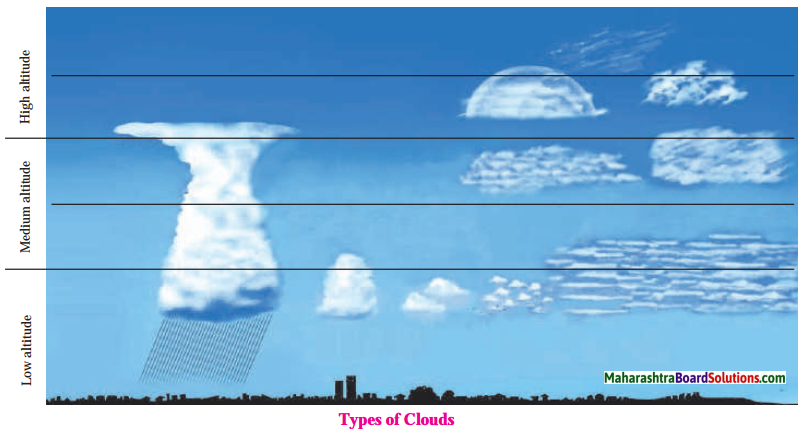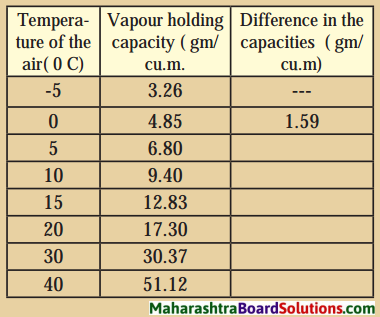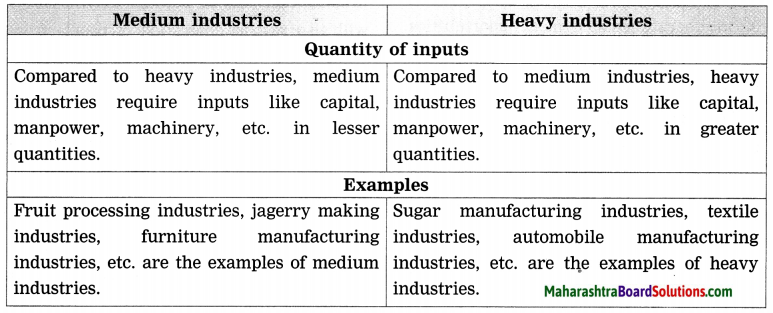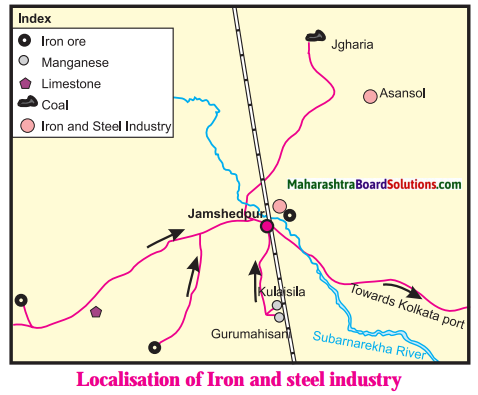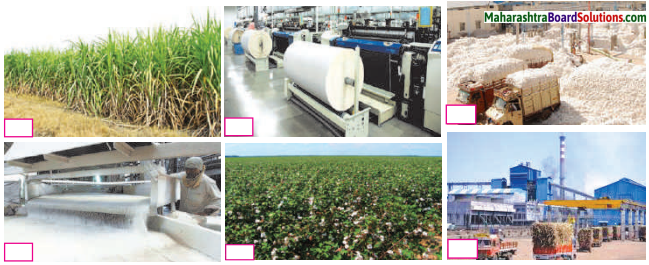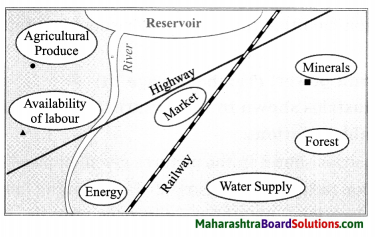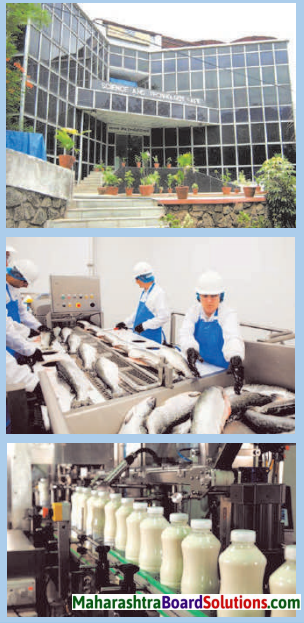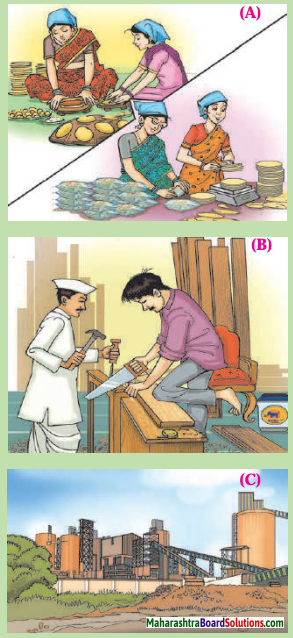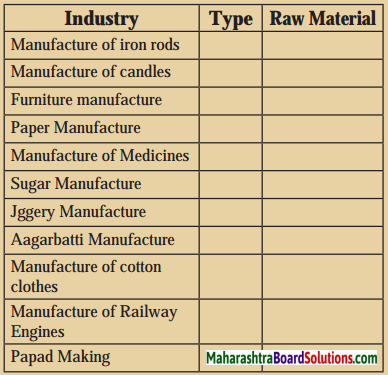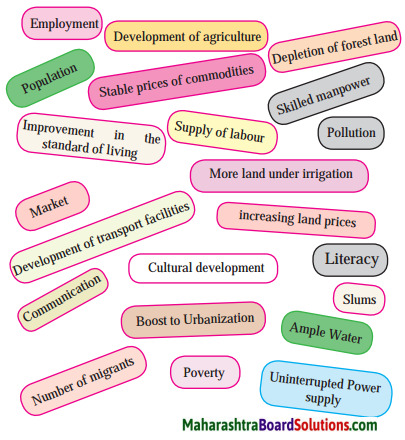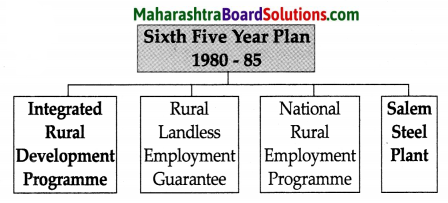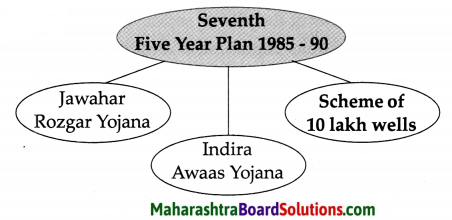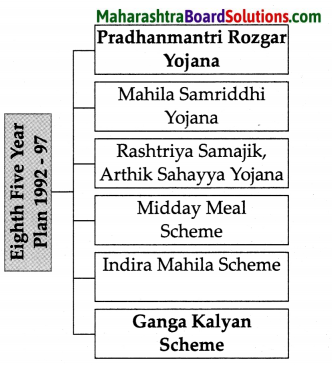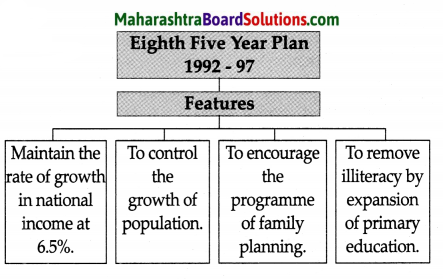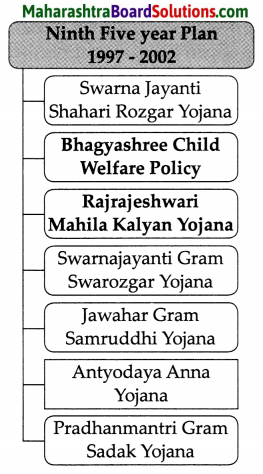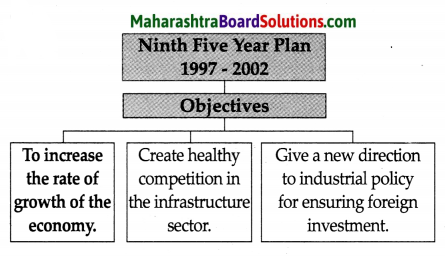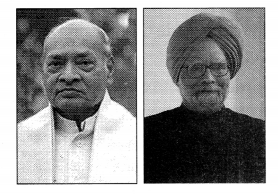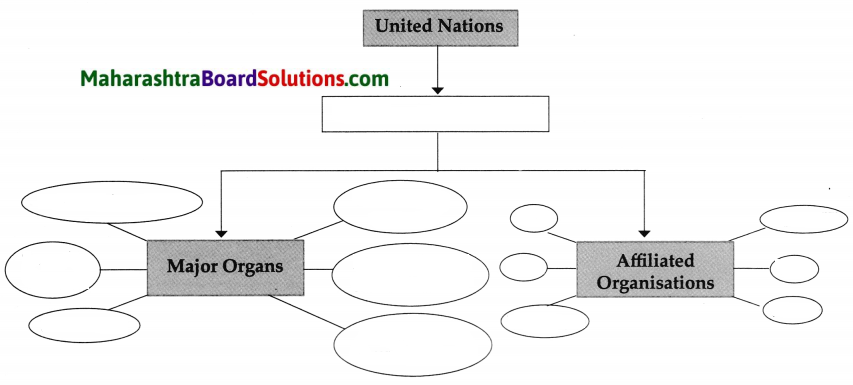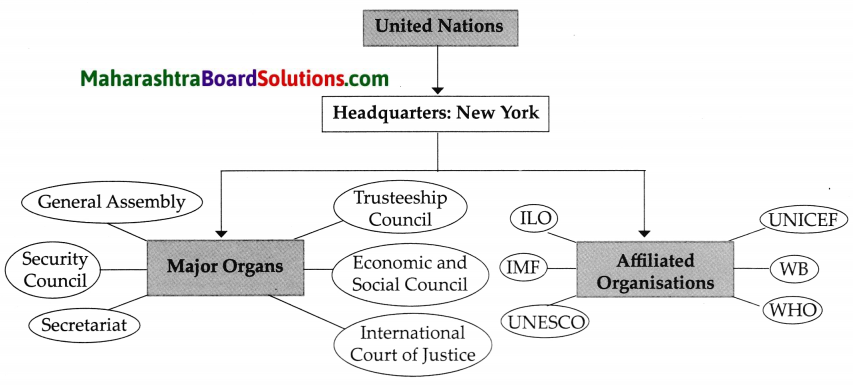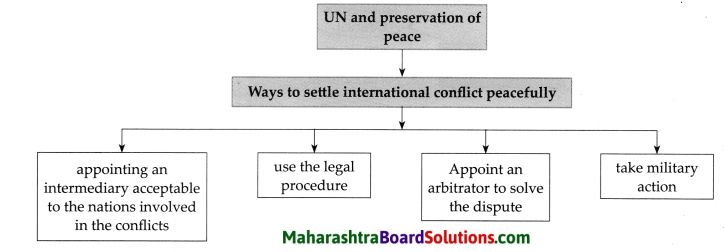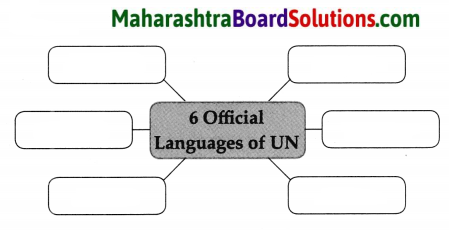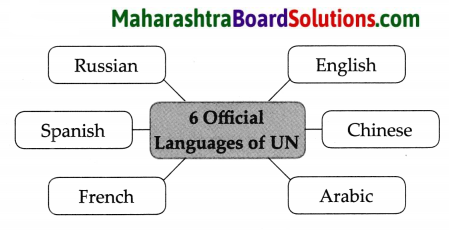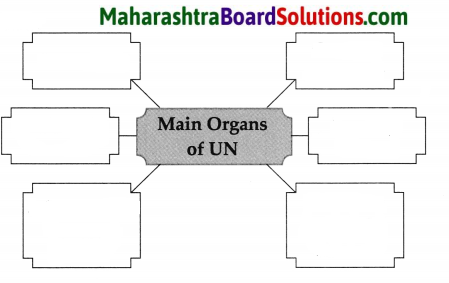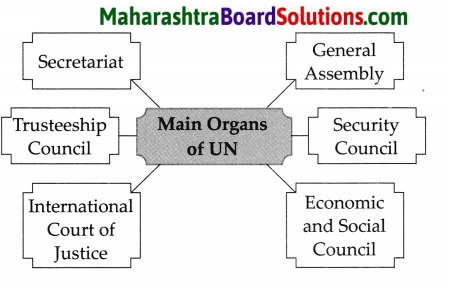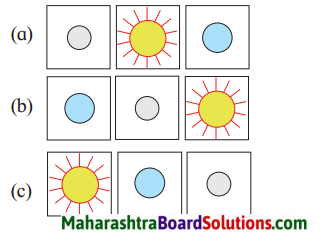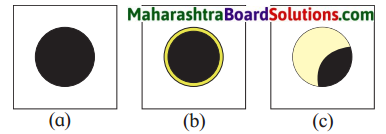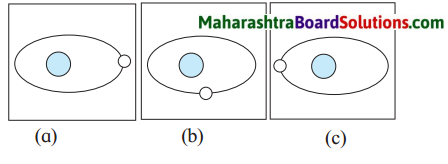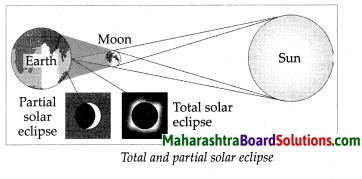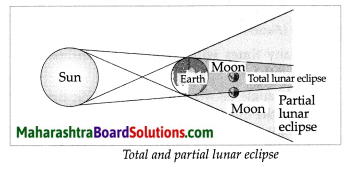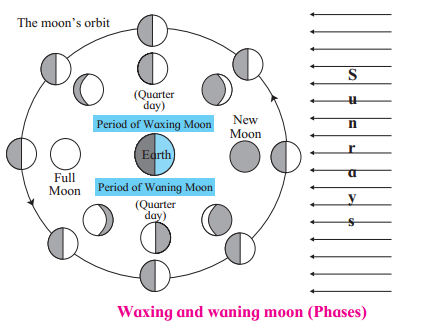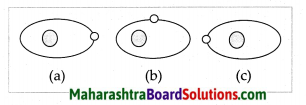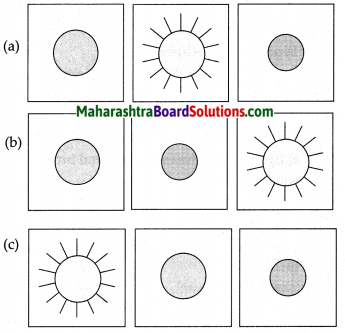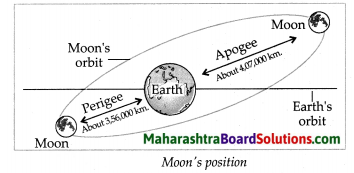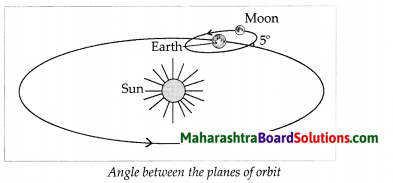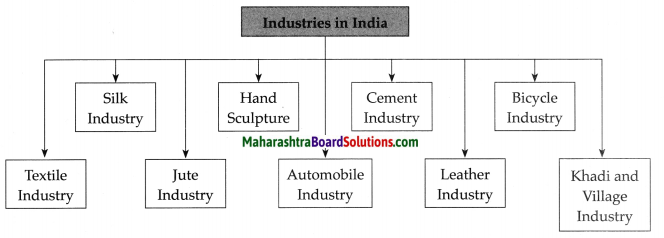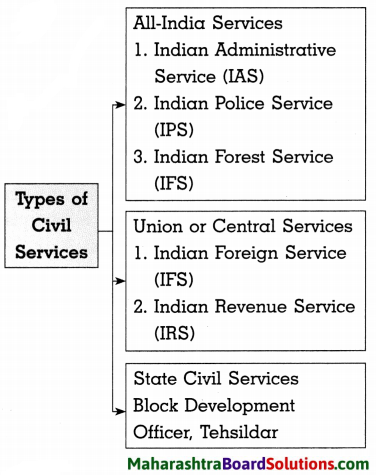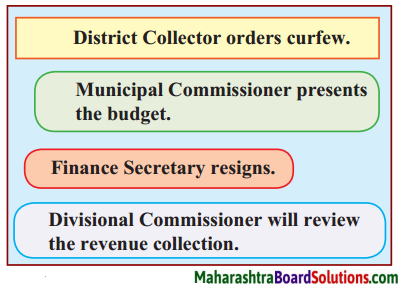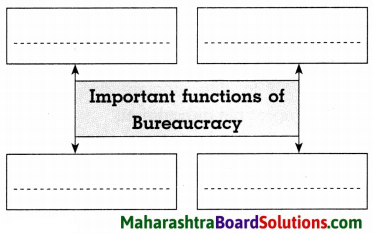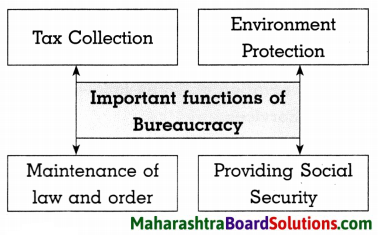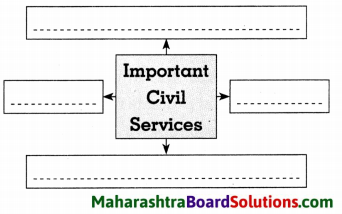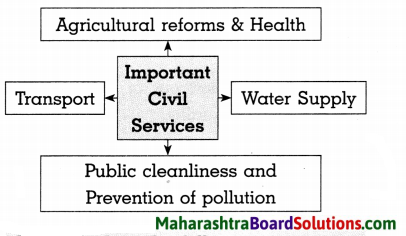Balbharti Maharashtra State Board Class 10 Geography Solutions Chapter 9 Tourism, Transport and Communication Notes, Textbook Exercise Important Questions and Answers.
Maharashtra State Board Class 10 Geography Solutions Chapter 9 Tourism, Transport and Communication
Class 10 Geography Chapter 9 Tourism, Transport and Communication Textbook Questions and Answers
1. State whether right or wrong with reasons.
Question a.
The future of tourism is bright in India due to its natural diversity.
Answer:
Right.
Question b.
Tourism is an invisible trade.
Answer:
Right.

Question c.
The indicator of development in a country is the development of transport in that country.
Answer:
Right
Question d.
Brazil’s time is ahead of India’s time.
Answer:
Wrong
Question 5.
The development of tourism in India has begun recently.
Answer:
Right.
2. Answer in short:
Question a.
Which factors attract more tourists in Brazil?
Answer:
The factors which attract more tourists in Brazil are:
- Clean, white sand beaches
- Attractive seacoasts
- Beautiful islands
- Beautiful orchards
- Deep dense forests of Amazon
- Various birds and animals
- Cities like the new capital city of Brasilia, Rio-de- Janeiro and Sao Paulo.
- Eco-tourism
Question b.
What are the difficulties in the development of the railway system in Brazil’s internal areas?
Answer:
- The densely forested lands of Amazon River Basin and the swampy lands have limited the development of railways in Brazil.
- Large pockets of Brazil are unpopulated. Roadways are the most common mode of transportation in the Eastern part of Brazil and waterways have developed on a commercial basis in the Amazon River.
- The trains are used for long distance transportation of passengers only in a few cities and by tourists. These are the difficulties in the development of the railway system in Brazil’s internal areas.

Question 3.
A plane leaves Brasilia at 11 a.m. on 31st December. The plane crosses 0° Meridian and reaches Vladivostok via New Delhi. Tell the local time, date and day at New Delhi and Vladivostok when the plane leaves Brasilia.

Answer:

Time difference between Brasilia and GMT = 3 hours
Time at GMT = 11 a.m.+3 hours
= 2.00p.m.

Time difference between GMT and New Delhi = 5 hours 30 min.
Time at New Delhi = 2 a.m. + 5 hours 30 min.
= 7 hours 30 min.
= 31st December,
Sunday, 7.30 p.m.

Time difference between
New Delhi and Vladivostok = 4 hours 30 min.
Time at Vladivostok = 7.30 p.m. + 4 hours 30 min.
= 12.00 am

The local time, date and day at Delhi are 7 : 30p.m. , 31st December, Sunday
local time, date and day at Vladivostok are 12 am. , 1st January, Monday.
4. Match the following:
| Column A’ | Column ’B’ |
(1) Trans-Amazonian
(2) Road Transport
(3) Rio de Janeiro
(4) Manmad | (a) Tourist Place Highway
(b) Railway Station in India
(c) Golden Quadrilateral
(d) Major Highway
(e) 40° W Meridian |
Answer:
1 – d
2 – c
3 – a
4 – b
5. Give geographical reasons:
Question a.
Eco-tourism is being developed more in Brazil.
Answer:
- Eco-tourism means responsible travel to natural areas without causing damage to the environment.
- Brazil has the largest number of vegetation species in the world including Amazon, the largest rainforest of the world and a great diversity of wild life.
- It has clean white sand beaches, attractive seacoasts, beautiful islands and orchards. Looking at the sensitivity of the natural resources in Brazil, ecotourism is being developed here.

Question b.
The internal waterways are not developed in Brazil.
Answer:
- Most of the rivers in Brazil flow with high speed.
- The amount of discharge of many rivers is very huge.
- In Brazil, rigid topography is found at many places near river basins. Many of the areas near rivers are inaccessible.
- Therefore, internal waterways are not developed in Brazil.
Question c.
A dense network of railways has developed in the North Indian Plains.
Answer:
- The North Indian Plains are flat plain lands with a dense population.
- Due to agricultural development, many agro- based industries have developed here.
- Thus there is a high demand for transportation especially railways for movement of freight and passenger transport.
Question d.
Development of transport is important for the country’s progress.
Answer:
- Transport modes help is the movement of humans, animals and goods from one location to another.
- Transport enables social, economic and cultural development of the country.
- Road transport facilitates door-to-door service.
- Rail transport is suitable for long distance and bulky goods.
- Water transport plays an important role in international trade and suitable for bulky goods.
- Air transport provides the fastest means of transportation.
Question e.
We rely on the sea routes for international trade.
Answer:
- Waterways is the cheapest modes of transportation for bulky and perishable goods over long distances.
- International trade includes import and export of goods.
- India is surrounded by Bay of Bengal, Arabian Sea and India Ocean, therefore we have a long coastline.
- So we rely on the sea routes for international trade.

6. Differentiate between:
Question a.
Water transport in the Amazon and the Ganga river.
Answer:
| Water transport in the Amazon River | Water Transport in the Ganga River |
(i) River Amazon is navigable throughout its course due to its gentle slope.
(ii) Boats ply from Equitos in Peru to its mouth i.e., approximately 3700 km.
(iii) River Amazon is used for navigation between Brazil and neighbouring countries. | (i) River Ganga is navigable only in its middle and lower course which is gentler as compared to its upper course.
(ii) Boats ply from Allahabad to Haldia. i.e. approximately 1620 km.
(iii) River Ganga is used for inland transportation. |
Question b.
Communication in Brazil and India
Answer:
| Communication in Brazil | Communication in India |
(i) Telecommunication services in Brazil are well developed and efficient.
(ii) Brazil is developing technology to send domestically-made satellites into space with its own rockets. | (i) With the explosion of electronic media, telecommunication industry has become one of the fast growing sectors.
(ii) With development of our own satellites, India has come a long way in this field. |
Question c.
IST and BRT
Answer:
| IST | BRT |
| (i) 1ST is the Indian Standard Time. | (i) BRT is the Brasilia Time/Brazil Time. (Standard Time) |
| (ii) India has only one standard time zone. | (ii) Brazil has four time zones. |
| (iii) The official 1ST is based on 82.5° E longitude | (iii) The official BRT is GMT – 03 which passes |
| which passes through Allahabad, Uttar Pradesh. | through Brasilia. |
| (iv) 1ST is 5hrs 30mins ahead of Greenwich Meridian | (iv) BRT is 2,3,4, or 5 hrs behind Greenwich Meridian |
| (v) Time as India is in the eastern hemisphere. | (v) Time as Brazil is in the western hemisphere. |
7. Write short notes on:
Question a.
Modem means of communication:
Answer:
(i) Modern means of communication includes landlines as well as mobile services, television broadcasting and computer/internet access.
(ii) In this era of information and communication technology, digitally enhanced communication devices like mobile phones, smart phones, internet and satellites are being used.
Question b.
Air transport in India:
Answer:
(i) Air transport is more developed in India as compared to Brazil.
(ii) The use of international and internal airways is increasing.
(iii) Important airports from where domestic and foreign travel take place are Mumbai, Delhi, Kolkata, Chennai, Bengaluru, etc.
Question c.
Correlation between physiography and internal waterways:
Answer:
(i) Internal (Inland) waterways comprises of rivers, canals, backwaters, creeks, etc. which are the cheap means of transportation.
(ii) Deep waters, gentle slopes, absence of rapids and waterfalls and the long course of rivers are favourable factors for development of internal waterways.
(iii) The longest waterways in the world is developed in the Amazon river in Brazil which is navigable for around 3700 kms.
(iv) Perennial river like Ganga in India is navigable in its lower course but the peninsular rivers are not used due to shallow waters, shorter course, seasonal nature, etc.
Question d.
Importance of Standard Time:
Answer:
(i) Standard Time is the official time and is commonly accepted all over the country or region.
(ii) The importance of Standard Time is the most, if the country has a vast longitudinal extent, since there will be a great difference between the time of its places located in the eastern and the western parts.
(iii) It helps in making proper schedules of travel, business meeting, co-ordinating the functioning of various organisations, etc.
(iv) Thus Standard Time helps in avoiding confusion regarding day, date and time.
Class 10 Geography Chapter 9 Tourism, Transport and Communication Intext Questions and Answers
Answer the following questions on the basis of the map given.
Observe the map carefully and answer the following questions:
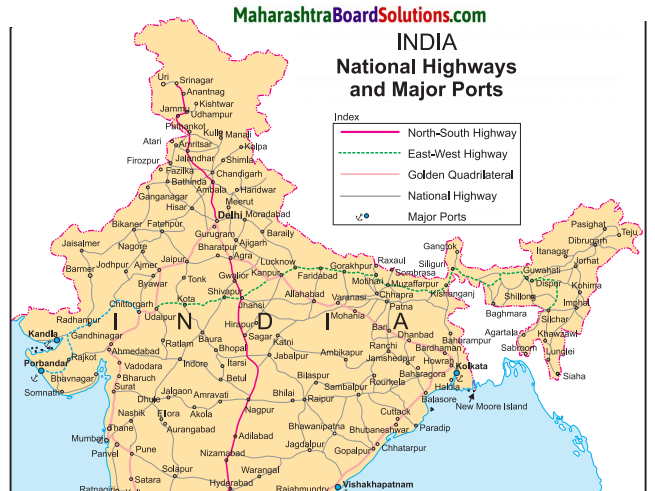
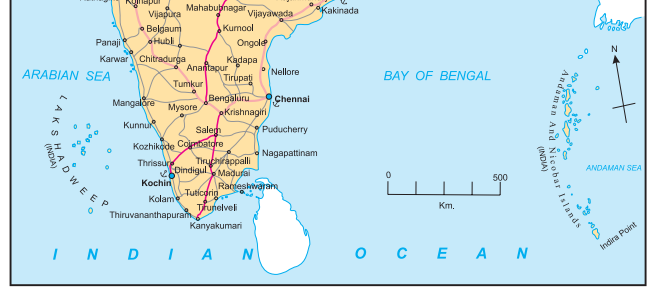
Question 1.
Name the terminal points of the North-South Corridor of Golden quadrilateral Highway.
Answer:
North – Srinagar, South – Kanyakumari.
Question 2.
Name the terminal points of East-West corridor Golden Quadrilateral highway.
Answer:
East – Silchar ; West – Porbandar.

Question 3.
Name the three major ports on the western coast.
Answer:
Porbandar, Mumbai and Cochin are the three major ports on the western coast.
Question 4.
Name the three major ports on the eastern coast.
Answer:
- Chennai
- Vishakhapatnam and
- Haldia
Question 5.
(Kolkata) are the three major ports on the eastern coast. Which parts of India have a spare network of road transport route? Give reason.
Answer:
The northernmost part of India in the state of Jammu and Kashmir does not have any national highway or other roadways, because it is a mountainous region.
Observe the given map carefully and answer the following questions:

Question 1.
What does the map indicate ?
Answer:
The map indicates the important railway routes and airports of India.
Question 2.
Which part of India has many airports compared to the others?
Answer:
The Southern part of India (i.e.) Peninsular India has many airports compared to the other parts of India.
Question 3.
Which part of India has a dense network of rail routes?
Answer:
North Indian plains region has a dense network of rail routes.
Question 4.
Name the northernmost important railway station.
Answer:
Baramulla is the northernmost important railway station.
Question 5.
Name the easternmost important railway station.
Answer:
Tinsukia is the easternmost important railway station.
Question 6.
Name the two westernmost important railway stations.
Answer:
Okha and Naliya are the two westernmost important railway stations.

Try this
Look at the graph and answer the following questions:
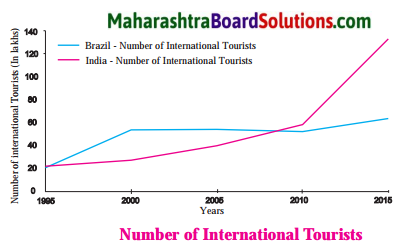
Question 1.
Which country attracted more international tourists in the year 1995?
Answer:
India attracted more international tourists in the year 1995.
Question 2.
In which country did more international tourists arrive in the year 2000?
Answer:
More international tourists arrived in Brazil in the year 2000.
Question 3.
In which year can an increase be seen in the number of international tourists in India?
Answer:
An increase in the number of international tourists in India can be seen from the year 2010.
Question 4.
What was the number of international tourists in the year 2015 in both the countries? What was the difference between them?
Answer:
The number of international tourists in India in 2015 was approximately 130 lakhs. The number of international tourists in Brazil in 2015 was 60 lakhs. The difference between India and Brazil in the numbers of international tourists in 2015 was 70 lakh people. (130 lakhs – 60 lakhs).
Question 5.
What could be the reason of increase in tourists in India after the year 2010?
Answer:
There is an increase in tourists coming to India after 2010 because :
- Different types of tourism like eco-tourism, health tourism, business tourism, etc. have been promoted by the Indian Government.
- The quality of travel and stay in India has also improved.
Question 6.
Name the kind of graph shown above.
Answer:
Polyline graph.
Can you tell ?
Look at the graph and answer the following questions:
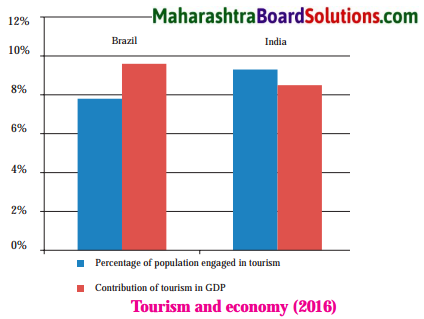
Question 1.
What type of graph is shown here?
Answer:
The type of graph shown here is a Joint Bar Graph.
Question 2.
What does the graph show?
Answer:
The graph shows:
- The percentage of population engaged in tourism in Brazil and India in 2016.
- The contribution of tourism in GDP by both the countries in 2016.

Question 3.
Which country’s tourism has a larger share in the contribution towards GDP?
Answer:
Brazil’s tourism has a larger share in the contribution towards GDP.
Question 4.
Which country has a larger population engaged in tourism sector but contributes lesser in GDP?
Answer:
India has a larger population engaged in tourism sector but contributes lesser in GDP terms.
Question 5.
How much percentage of India’s population is engaged in tourism?
Answer:
Nearly 9.5 percentage of Indian population is engaged in tourism.
Question 6.
How much is the contribution of tourism in India’s GDP in 2016? .
Answer:
The contribution of tourism in India’s GDP in 2016 is nearly 8.5 per cent.
Make friends with maps
Study the transport map of Brazil and answer the following.

Question 1.
Which means of transport are seen on the map?
Answer:
All the means of transport like roadways, railways, airways, and waterways are seen on the map.
Question 2.
Which means of transport has a denser network?
Answer:
The roadways have a denser network.
Question 3.
Which highway can be seen prominently? Which places does it join?
Answer:
The Trans Amazonian Highway can be seen prominently. It connects Cruzeiro do sul, Porto Velho, Manaus and Brasilia.
Question 4.
What could be the reason for the development of railways in the South-East?
Answer:
(i) South-east Brazil is the richest and the most populated region of the country.
(ii) Agriculture, mining, and tourism are well developed in this part of Brazil.
Question 5.
In which part of Brazil do you see a lesser development of transport network? What could be the reason?
Answer:
(i) Amazon in the north and Pantanal in the west have lesser development of transport network.
(ii) Amazon in the north due to dense forest cover whereas Pantanal is a swampy land.
Think about it.
Question 1.
Considering the development of transport in a place, which factors do you think are responsible for the development of transport in Brazil? Also, think which means of transport could be used in Brazil given its topography and drainage?
Answer:
Considering the development of transport in a place, the factors that are responsible for the development of transport in Brazil are:
- The physiography, accessibility, population, climatic conditions, availability of power/fuel, funds, etc.
- Roads and ports need to be upgraded.
- Railways are few and competitive. They can be increased in the central part.
- With its topography and drainage Brazil should develop more waterways.
Activity
Look at the transport maps of India and the make friends with maps.



Question 1.
Which means of transport are visible on the map?
Answer:
The means of transport used are roadways and waterways.
The means of transport used are railways and airways.
Question 2.
In which part of India is the density of railways more?
Answer:
The density of railways is more in the Northern Plains region.

Question 3.
Name five important ports and airports of India.
Answer:
Ports: Mumbai ,Vishakhapatanam, Haldia, Chennai and Kandla.
Airports: Delhi, Mumbai, Bengaluru, Chennai, and Kolkata.
Question 4.
Which parts of India have a sparse network of transport? What could be the reason?
Answer:
(i) The north and the north-east parts of India have a sparse network of transport.
(ii) Due to mountainous and snow covered areas in the north and the dense inaccesible forest areas of the north-east, the transportation network is sparse here.
(iii) Also these regions have low population and lack of economic opportunities.
Give it a try.
Question 1.
Arun called his mother from Digboi at 7 am. At what local time will his mother pick up his call at Jaisalmer?
Answer:
Arun’s mother will pick his call at 5.00 am. local time at Jaisalmer.
Question 2.
Calculate the difference in time between the two points in minutes.
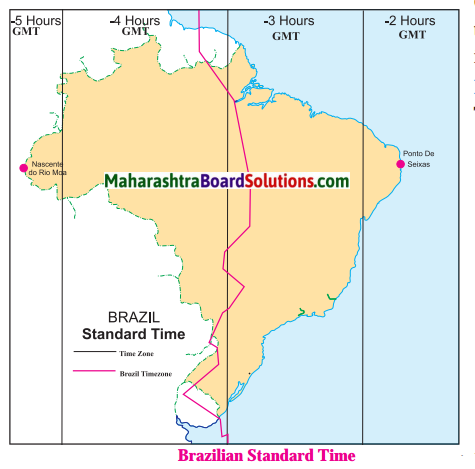
Westernmost point: Nascente do Rio Moa (07° 32’33″S, 70° 59’W) Easternmost point: Ponta do Seixas, Paraiba (07° 09′ 28″S, 34° 47’W),
Answer:
The difference in time between the Easternmost and the Westernmost part of Brazil is 168 minutes.
Activity
Read the map and answer the following questions:

Question 1.
How many divisions can you see in the map?
Answer:
We can see 4 divisions in the map.
Question 2.
What do these divisions signify?
Answer:
These divisions signify the time zones in Brazil.
Question 3.
What does the term ’behind the GMT’ mean?
Answer:
The Greenwich Meridian Time is a time set with reference to 0° longitude that passes through Greenwich. The countries lying to the west of 0° longitude are ’behind the GMT’.
Question 4.
Which part of Brazil is ahead of other?
Answer:
The easternmost part of Brazil is ahead of the other parts.

Question 5.
By how many minutes is this part ahead of others?
Answer:
60 to 180 minutes.
Question 6.
What does the red line in the map show?
Answer:
The red line in the map is the official BRT which is in the GMT-03 time zone. It is 3 hours behind GMT.
Make friends with maps
Study the map given in figure and answer the following questions:
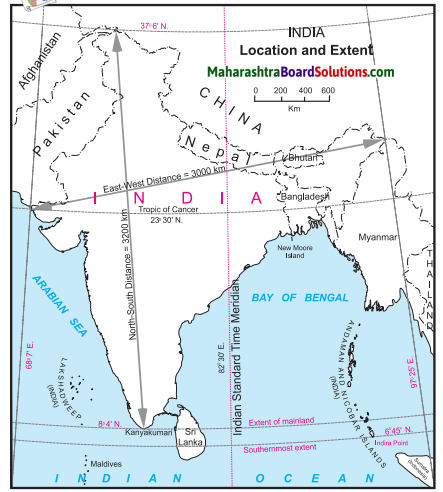
Question 1.
Calculate the difference between the two longitudinal extremes of mainland India. Is it more than Brazil?
Answer:
The difference between the two longitudinal extremes of east and west mainland India is about 29°.
Question 2.
Which longitude in India is called the Indian Standard Time (IST)?
Answer:
The 82° 30′ E longitude is called Indian Standard Time (IST)
Question 3.
What is the difference between IST and the GMT?
Answer:
The IST time is 5 hours and 30 minutes ahead of the GMT.
Question 4.
How many local times are there in India?
Answer:
There are 29 local times.
Question 5.
How much is the time difference between the western most and the eastern most points of India?
Answer:
Two hours, 120 minutes.
Think about it.
Question 1.
It is 12 noon at Delhi. What would be the local time in Brasilia?
Answer:
If it is 12 noon at Delhi, the local time in Brasilia would be 3.30 a.m. This is because Brasilia is 3 hours behind GMT and Delhi is 5 hours 30 minutes ahead of GMT. Therefore

Time difference between Brasilia and Delhi is of 8 hours 30 mins (3 hours + 5 hours 30 mins) Time at Delhi = 12 noon
Time at Brasilia = 12 noon – 8 hours 30 mins
= 3.30 a.m.
Use your brain power
Question 1.
Saurabh and Ashwini work for a MNC. Two of their regional head offices are located in Brazil in Rio De Janeiro and Manaus, respectively. Both of them have to contact either of the head offices constantly.
As they have to adjust timings according to their head offices, find out their corresponding timings in India, if they work according to office timings in Brazil, i.e 10 a.m. to 5 p.m.
Answer:
(i) Let us assume Saurabh is coordinating with Rio De Janeiro’s head office and Ashwini is coordinating with the head office of Manaus.
(ii) Brazil has four time zones. It is behind the GMT by 2, 3, 4 or 5 hours.
(iii) Rio De Janeiro is in the 2nd time zone which is 3 hours behind GMT (GMT-03) and Manaus is the 3rd time zone which is 4 hours behind GMT (GMT-04).
(iv) Now, the time difference between GMT and 1ST is of 5 hours 30 mins.
They have to make following adjustments :
| Saurabh |
| Rio De Janeiro | GMT | IST |
| 10 a.m. | 1 p.m. | 6.30 p.m. |
| 5 p.m. | 8 p.m. | 1.30 a.m. |
| Ashwini |
| Manaus | GMT | IST |
| 10 a.m. | 2 p.m. | 7.30 p.m. |
| 5 p.m. | 9 p.m. | 2.30 a.m. |
Rio De Janeiro is in the 2nd time zone which is 3 hours behind GMT (GMT-03) and Manaus is the 3rd time zone which is 4 hours behind GMT (G
Corresponding timings in India Saurabh: 6.30 p.m. to 1.30 a.m. Ashwini: 7.30 p.m. to 2.30 a.m.
Give it a try
Question 1.
On what basis will you decide how many standard times should be there in a country?
Answer:
The longitudinal extent of a country will help one decide how many standard times should be there in a country.
Class 10 Geography Chapter 9 Tourism, Transport and Communication Additional Important Questions and Answers

Choose the correct option and rewrite the statements:
Question 1.
The new capital city of Brazil is ______.
(a) Rio de Janeiro
(b) Sao Paulo
(c) Manaus
(d) Brasilia
Answer:
(d) Brasilia
Question 2.
A city that attracts a lot of tourists is _______.
(a) Rio de Janeiro
(b) Brasilia
(c) Manaus
(d) Ponta de Seixas
Answer:
(a) Rio de Janeiro
Question 3.
The proportion of the Indian population engaged in tourism is proportionately _____ Brazil.
(a) lower than
(b) higher than
(c) equal to
(d) extremely lesser than
Answer:
(b) higher than
Question 4.
The football stadium at ______ is quite well known
(a) Rio de Janeiro
(b) Manaus
(c) Sao Paulo
(d) Boa Vista
Answer:
(b) Manaus
Question 5.
The most common method of transportation in Brazil is ____.
(a) railways
(b) waterways
(c) roadways
(d) airways
Answer:
(c) roadways
Question 6.
The density of road network in Brazil is concentrated in the ____ part of the country.
(a) southern
(b) northern
(c) western
(d) eastern
Answer:
(d) eastern
Question 7.
The forested lands of the Amazon River basin and the ______ lands have limited the development of roadways in this part of Brazil.
(a) drought-prone
(b) fertile
(c) swampy
(d) semi-arid
Answer:
(c) swampy
Question 8.
Waterways have been developed on a commercial basis in the _____ river.
(a) Amazon
(b) Uruguay
(c) Purus
(d) Aragua
Answer:
(a) Amazon
Question 9.
Boats ply from _____ in Peru to the mouth of the river Amazon.
(a) Lima
(b) Cusco
(c) Equitos
(d) Nazca
Answer:
(c) Equitos
Question 10.
Apart from R. Amazon, another important river for waterways is the ____ Parana river.
(a) south-flowing
(b) north-flowing
(c) east-flowing
(d) west-flowing
Answer:
(a) south-flowing
Question 11.
The contribution of ______ is less in the transportation system of Brazil.
(a) railways
(b) roadways
(c) waterways
(d) airways
Answer:
(d) airways
Question 12.
Railway network is dense in the ______ of India.
(a) hilly states
(b) north-eastern states
(c) central parts of India
(d) north indian plains
Answer:
(b) north-eastern states
Question 13.
Approximately, 95% of foreign trade moves through ______ routes, in India.
(a) road
(b) rail
(c) air
(d) ocean
Answer:
(d) ocean
Question 14.
The westernmost extreme point on mainland Brazil is ______.
(a) Rio Grande
(b) Rio de Janeiro
(c) Nascente do Rio Moa
(d) Ponta do Seixas
Answer:
(c) Nascente do Rio Moa

Question 15.
The easternmost extreme point on mainland Brazil is ______
(a) Rio Grande
(b) Sao Paulo
(c) Ponta do Seixas
(d) Nascente do Rio Moa
Answer:
(c) Ponta do Seixas
Question 16.
Brazil has ______ time zones.
(a) 3
(b) 4
(c) 5
(d) 6
Answer:
(b) 4
Question 17.
(BRT) Brazil time is _____ hours behind GMT.
(a) three
(b) four
(c) five
(d) six
Answer:
(a) three
Question 18.
Today, more than 45% of the Brazilian population has access to the ______.
(a) mobile services
(b) television broadcasting
(c) radio broadcasting
(d) internet
Answer:
(d) internet
Question 19.
The telecommunication infrastructure is fairly modern, particularly in ____ Brazil.
(a) north
(b) north-west
(c) north-east
(d) central-south
Answer:
(d) central-south
Question 20.
______ services in Brazil are well-developed and efficient.
(a) Air
(b) Railway
(c) Helicopter
(d) Telecommunication
Answer:
(d) Telecommunication
Question 21.
With regard to telecommunication infrastructure, the north and ______ are drastically less developed.
(a) south
(b) south-west
(c) north-west
(d) central-south
Answer:
(c) north-west
Question 22.
Over recent years, _______ have led to the rapid expansion of telecommunication services in Brazil.
(a) landline phones
(b) radio broadcasting
(c) television broadcasting
(d) mobile telephones
Answer:
(d) mobile telephones
Question 23.
India has ______ standard time zone/s.
(a) one
(b) two
(c) three
(d) four
Answer:
(a) one
Question 24.
The difference between the two extreme most points in India is about _____.
(a) 120 minutes
(b) 210 minutes
(c) 168 minutes
(d) 186 minutes
Answer:
(a) 120 minutes
Question 25.
The difference between the two extreme most points of Brazil is _______.
(a) 186 minutes
(b) 168 minutes
(c) 120 minutes
(d) 200 minutes
Answer:
(b) 168 minutes
Question 26.
The 82°30’E longitude is the Indian Standard Time longitude which passes though ________.
(a) Allahabad
(b) Ahmedabad
(c) Hyderabad
(d) Muzzaffarabad
Answer:
(a) Allahabad
Question 27.
India is one of the largest users of _______ and internet.
(a) landlines phones
(b) television
(c) radio
(d) smartphones
Answer:
(d) smartphones
Question 28.
About 85% of passenger and 70% of freight traffic are carried by every year in India.
(a) roadways
(b) railways
(c) waterways
(d) airways
Answer:
(a) roadways

Question 29.
______is the official time of Brazil.
(a) GMT-01
(b) GMT-04
(c) GMT-03
(d) GMT-02
Answer:
(c) GMT-03
Question 30.
The prominent highway of Brazil is ________.
(a) Trans Belem Highway
(b) Trans Rio Grande Highway
(c) Trans Amazonian Highway
(d) Trans Brasilia Highway
Answer:
(c) Trans Amazonian Highway
Match the following:
Question 1.
| Column ’A’ | Column ‘B’ |
| (1) The new capital city | (a) Rio de Janeiro |
| (2) The city attracting a lot of tourist | (b) Manaus |
| (3) Football stadium | (c) Peru |
| (4) Beach | (d) Brasilia |
| (5) Equitos | (e) Sao Paulo |
| (f) Boa Vista |
Answer:
1 – d
2 – e
3 – b
4 – a
5 – c
Answer the following questions in one sentence:
Question 1.
State the factors that attract foreign tourists towards India.
Answer:
Foreign tourists visit India to see and understand its rich heritage and culture, for adventure, to avail the health services and for business purposes.
Question 2.
What is the kind of service provided by roadways in India?
Answer:
About 85% of passenger traffic and 70% of freight traffic are carried by roadways every year in India.
Question 3.
How important are the inland waterways in India’s transportation?
Answer:
Inland waterways comprising rivers, canals, backwaters, creeks, etc., which contribute about only 1% to India’s transportation.
Question 4.
In what way are the ocean routes useful for India?
Answer:
Approximately 95% of India’s foreign trade moves through ocean routes.
Question 5.
What kind of advanced space technology is Brazil developing?
Answer:
Brazil is developing technology to send domestically-made satellites into space with its own rockets.
Question 6.
Write a short note about the telecommunication infrastructure in different parts of Brazil.
Answer:
The telecommunication infrastructure is fairly modern, particularly in central-south Brazil, but the north and north-west are drastically less developed.
Question 7.
Why have roadways not developed in the north and north-western part?
Answer:
The forested lands of the Amazon River basin and the swampy lands have limited the development of roadways in the north and north-western region.
Question 8.
Which time zone is considered to be the official Brazilian time?
Answer:
GMT-03 Time Zone is considered to be the official Brazilian time.
Distinguish between:
Question 1.
The use of railways in Brazil and India.
Answer:
| The use of railway in Brazil | The use of railway in India |
| (i) Railways have not developed very well in Brazil. | (i) Compared to Brazil, India has a denser network of railways. |
| (ii) The use of trains for long distance transportation is restricted to a few urban tourist routes though it is cheaper. | (ii) Freight and passenger transport have been facilitated due to the development of the railways, which are considered very important for the growth of Indian economy. |
| (iii) Dense network of railways have developed in south and south-east Brazil as compared to other parts of Brazil. | (iii) Dense network of railways have developed in the North-Indian Plains as compared to other parts of India. |

Question 2.
The longitudinal extent of India and Brazil
Answer:
| The longitudinal extent of Brazil | The longitudinal extent of India |
| (i) Extreme westernmost point: Nascente do Rio Moa. (70°59’W) | (i) Extreme westernmost point : Ghuar Mota. (70°E) |
| (ii) Extreme easternmost point: Ponta do Seixas.(34047′ w) | (ii) Extreme easternmost point: Kibithu. (97°E) |
| (iii) Time difference is 168 minutes approximately 2 hrs 48 minutes. | (iii) Time difference is 120 minutes on mainland i.e., approximately 2 hrs. |
| (iv) There is a vast time difference between the extreme most points of Brazil due to vast longitudinal extent. | (iv) There is comparatively less time difference between the extreme points of India. |
Question 3.
The density of roadways in Brazil and India.
Answer:
| The density of roadways in Brazil | The density of roadways in India |
| (i) Roadways account for more than half of the transportation system in the country. | (i) As compared to Brazil, India has a denser network of transport. About 85% of passenger and 70% of freight traffic are carried by road every year. |
| (ii) Density of road network is high in the eastern | (ii) Density of road network is high in the North |
| part of the country. | Indian Plains in the northern part of India. |
Question 1.
Mark the following on an outline map of Brazil. Name the following:
- The new capital city of Brazil.
- Two cities that attract a lot of tourist.
- A south-flowing river important for waterways.
- The easternmost extreme point of mainland Brazil.
- The westernmost extreme point part of mainland Brazil.
Answer:
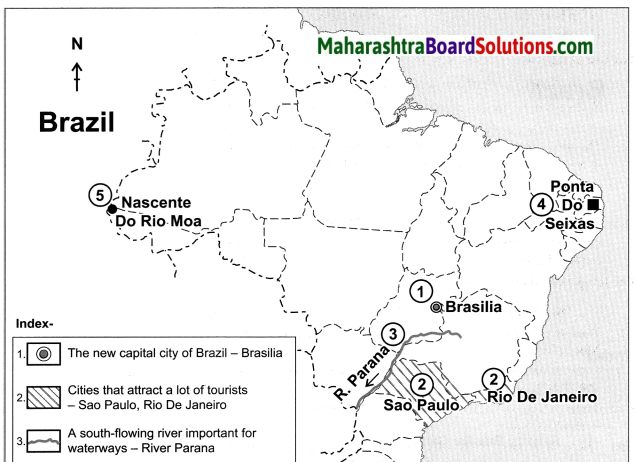

Question 2.
Show the following on a given outline map of Brazil.
Given index:
(A) Ports:
(B) Airports:
(C) Railway Junctions:

Answer:
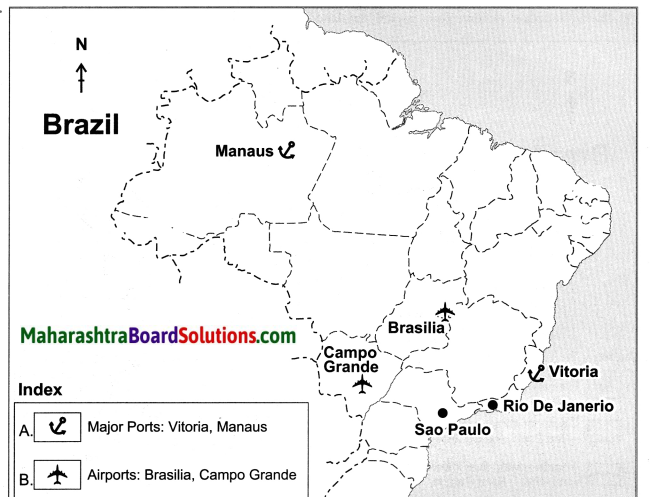

Question 3.
Show the following on a given outline map of India. Give index:
Given index:
(A) Ports:
- Chennai
- Porbandar
- Kochin
- Kandla
- Kolkata
(B) Airports :
- Bengaluru
- Delhi
- Pune
- Thiruvananthapuram
(C) Railway Junctions :
Answer:
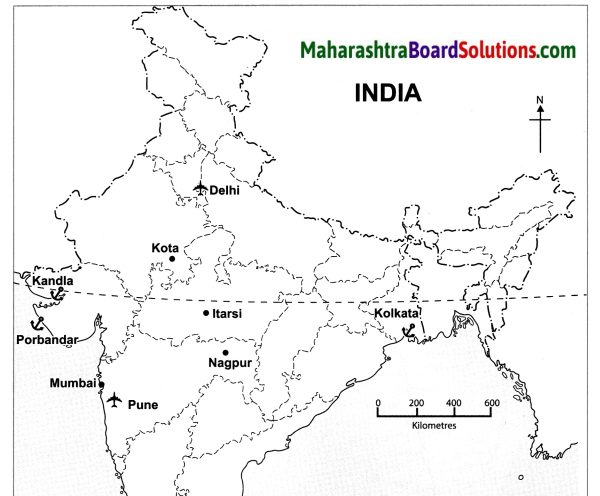
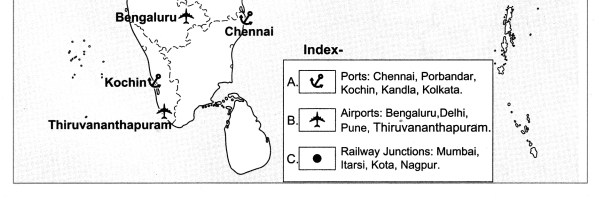
Give geographical reasons:
Question 1.
India’s contribution of tourism to its GDP appears lesser than Brazil and population engaged seems higher.
Answer:
(i) The number of international tourists visiting India in 2015 was more than that of Brazil.
(ii) Even though this is true, the share of tourism sector in the GDP is less than that of Brazil.
(iii) Apart from this, the proportion of Indian population engaged in tourism is higher than that of Brazil.
(iv) This is primarily dependent on the size of the population of those countries and the size of the GDP.
(v) According to the data available, the population of India is more than Brazil and so is its GDP.
(vi) As the GDP of India is higher than Brazil’s GDP to GDP appears lesser than Brazil’s and population engaged seems higher.

Question 2.
Railways are important for the growth of the Indian economy.
Answer:
(i) Railways are very important for a vast country like India where the distance between places is long.
(ii) Freight and passenger transport have been facilitated due to the development of the railways.
(iii) The more the facilities available for passenger transport and freight transport, the more growth in the economy.
Thus, the railways are very important for the Indian economy’s growth.
Question 3.
Brazil’s time is not ahead of India’s time.
Answer:
(i) The GMT i.e, Greenwich Mean Time, divides the globe into eastern and western hemisphere.
(ii) India lies to the east of GMT and Brazil lies to the West of GMT.
(iii) Places lying to the east of GMT, are ahead of time and places lying to the west of GMT (like Brazil) are behind time.
Question 4.
The future of tourism is bright in India.
Answer:
(i) India is rich in natural beauty that includes mountains, forests, plateaus, plains, islands, coastal areas, beaches, etc.
(ii) India also has a rich heritage and a huge variety of cultural and historical attractions.
(iii) In recent years new forms of tourism have been developed in India like Eco tourism, Agro tourism, Medical tourism, Film tourism, etc.
(iv) Also infrastructural facilities, branding and marketing initiatives have helped to promote Indian tourism.
So the future of tourism is bright in India.
Question 5.
Tourism is an invisible trade.
Answer:
(i) Tourism belongs to the service sector as various services are provided to the tourists.
(ii) For e.g., hotels, lodges, transport, food, entertainment, etc.
(iii) Tourism increase the GDP of economy without exchange of goods.
Thus, tourism is an invisible trade.
Question 6.
he indicator of development in a country is the development of transport in that country.
Answer:
(i) Transportation facilitates trade and creates employment opportunities.
(ii) With the development of transport there is socio-economic and cultural development of the country.
Hence it is an indicator of development in a country.
![]()



























